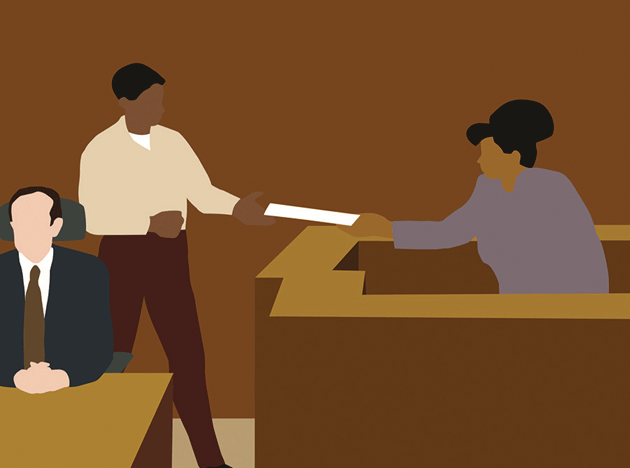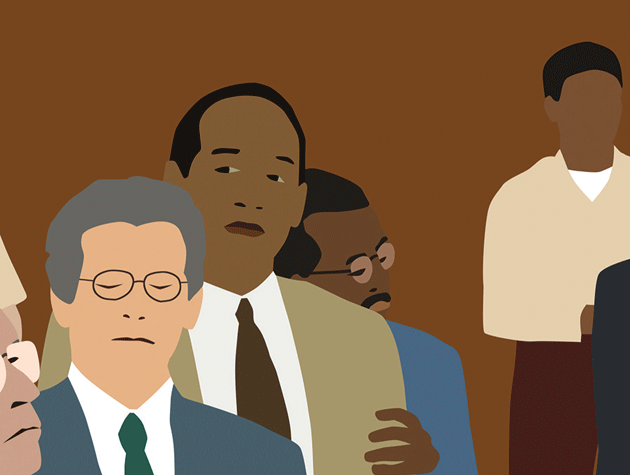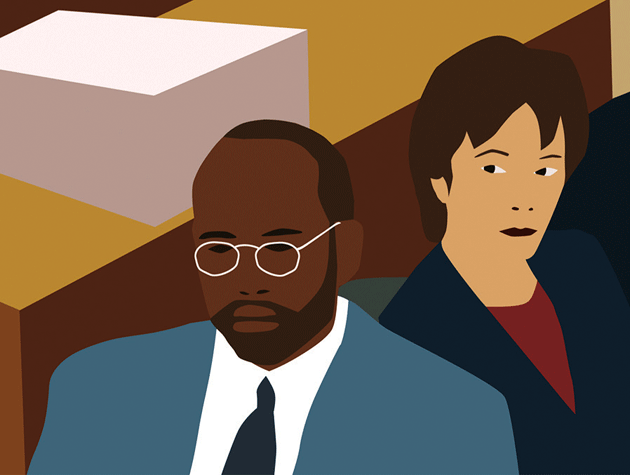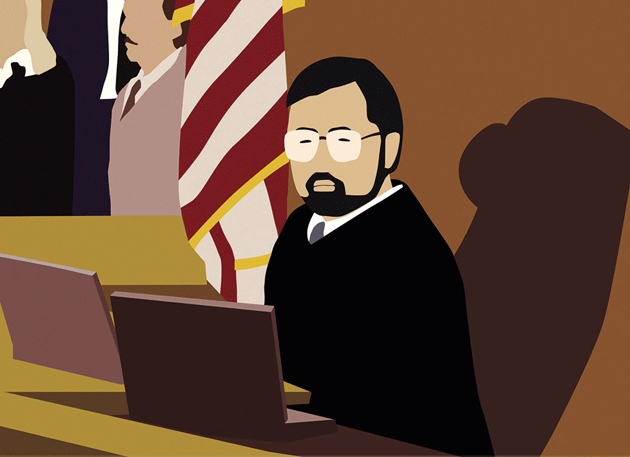The new docudrama The People v. O. J. Simpson: American Crime Story (FX) isn’t really about Orenthal James Simpson. It’s about the trials that ran alongside his — those informal, unboundaried, court-of-public-opinion trials in which evidence was heard for and against the murder victims, the defense and the prosecution, the judge, the jury, and the Los Angeles Police Department, to say nothing of white and black America. History has freed us from suspense about Simpson’s verdict, so that the man himself (played here by Cuba Gooding Jr.) is less the tragic hero he seemed in the mid-Nineties than a curiously minor character. He comes to the center of our attention only once, in Episode 2, at the end of the lengthy Ford Bronco chase scene — which in real life was followed by a surreal cavalcade of police cars and media helicopters, as well as an estimated 95 million live viewers — when Simpson repeatedly, and with apparent sincerity, apologizes for taking up so much of so many people’s time. It is an uncannily ordinary moment of social decorum, a sort of could-you-please-pass-the-salt gesture on a sinking Titanic, in which Simpson briefly becomes more than just an archetype.
Cue, then, the other players. Or rather, the other people we kept forgetting weren’t merely players. The People v. O. J. Simpson reminds us that the Simpson case became so obscured by symbolism and public emotion that even the dead — Nicole Brown Simpson, O. J.’s ex-wife, and her friend Ronald Goldman — were assessed for their likability. “Our focus group rated the participants on a scale of one to ten based on how much sympathy they felt,” an analyst reports to the defense team at one point. “Nicole scored sevens, fives, and a three. . . . One term came up a lot: ‘gold digger.’ ”
Both the prosecution and the defense conducted this sort of research in order to determine which jurors were, demographically, most likely to be persuaded to convict or acquit. In Episode 4, in a process that resembles test marketing for a new soft drink (or television show), a room of strangers is shown clips of the key figures in the trial and asked for their impressions. The lowest marks go to Marcia Clark, the lead prosecutor (played with subtlety by Sarah Paulson), a perfectly fine-behaving, fine-looking lawyer in perfectly fine clothes, whose appearance — unlike that of the mostly overweight and unattractive alpha men on the defense team — became a national obsession. The focus group gives Clark an average score of four, making comments such as “She seems like a bitch,” “She acts like everybody’s stupid,” and “I wouldn’t want to be her boyfriend.” (“Hello, Hillary!” the show all but says.)
The media are even pettier, providing little in the way of actual legal analysis. In one scene, Clark comes home just in time to overhear someone on the television news saying: “This is not a look; this is a cry for help.” In another scene, she walks into a grocery store and sees a rack of newspapers, each with variations on the headline guilty below photos of her new hairstyle.
 Naturally, the highest likability scores go to the wealthy, good-looking celebrity. “I don’t know what you guys are cheering for,” Christopher Darden, Clark’s assistant (Sterling K. Brown), says as his neighbors, watching the Bronco chase during a backyard barbecue, root for Simpson. “O. J. is local,” one responds. “He went to Galileo High.” “So what?” says Darden. “O. J. never gave back. Well, you see any parks around here? Any children’s centers? . . . Once O. J. made his money, he split and never came back. He became white.” Laughing, one of the neighbors answers, “Well, he got the cops chasing him — he’s black now.”
Naturally, the highest likability scores go to the wealthy, good-looking celebrity. “I don’t know what you guys are cheering for,” Christopher Darden, Clark’s assistant (Sterling K. Brown), says as his neighbors, watching the Bronco chase during a backyard barbecue, root for Simpson. “O. J. is local,” one responds. “He went to Galileo High.” “So what?” says Darden. “O. J. never gave back. Well, you see any parks around here? Any children’s centers? . . . Once O. J. made his money, he split and never came back. He became white.” Laughing, one of the neighbors answers, “Well, he got the cops chasing him — he’s black now.”
The People v. O. J. Simpson, which opens with footage of the crowded streets of Los Angeles after the officers who brutally beat Rodney King were acquitted of assault in 1992, resonates with the police shootings of unarmed black men that fill the news today. With its lens shifting from the courtroom to the newsroom to people’s back yards, the series evokes the way in which, for a brief, delusory moment, the O. J. verdict seemed to deliver justice for all black men. During the trial, the defense team holds several news conferences in which they make the compelling, if fudgy, case that their client is simply another victim of a racist police force. There are shots of crowds rallying behind a fleeing Simpson at highway overpasses with signs of go oj and the juice is loose.
The most straightforwardly villainous character in the show is police officer Mark Fuhrman (Steven Pasquale), the detective who investigated Brown and Goldman’s murders, and who was caught on tape saying, among other things, “People don’t want niggers in their town. People don’t want Mexicans. . . . And any way you can do to get them out is fine with them.” Although Fuhrman was later charged with perjury for his testimony in the Simpson trial (he pleaded no contest), he’s since had his record expunged, and is now a regular guest on Fox News. Some people just have a strong TV presence.
I watched The People v. O. J. Simpson, as I imagine many others did, in one uninterrupted, nostalgia- and thrill-intoxicated sitting. The first three episodes show a lot of the Kardashians, the Cochrans, and the district attorney Gil Garcetti. (David Schwimmer plays Simpson’s close friend and lawyer Robert Kardashian; Courtney B. Vance plays the defense attorney, Johnnie Cochran; and Bruce Greenwood plays Garcetti.) These cameolike moments — we feel we’re catching sight of the present in the past — are often amusing, as when a hostess at a hip L.A. restaurant greets Robert Kardashian, after a TV appearance, with a cheerful “You’re Robert Cordovian!” and shows him straight to a prime table.
Not everyone has it so good. In another episode, Marcia Clark is told that someone has come to see her at her office, but there are no TV cameras in sight, no one to analyze what she is wearing. A stranger enters in a state of grief and horror. The scene is unpleasant, and it lasts longer than you want it to. The man turns out to be Fred Goldman, Ronald’s father. “It’s like Ron is a footnote to his own murder,” he says. “And if they talk about him, they make him seem like some kind of joke.”
 This abrupt shift in perspective is one of The People v. O. J. Simpson’s many intelligent structural decisions, and it’s indicative of the way in which the show comes to grips with a narrative that has already been told, in great detail, many times before. The series works by focusing on the deforming effects of who and what received attention during the trial. A highly watchable show about the perils of watchability, it keeps reminding us of the uncountable murders and trials we aren’t keeping up with.
This abrupt shift in perspective is one of The People v. O. J. Simpson’s many intelligent structural decisions, and it’s indicative of the way in which the show comes to grips with a narrative that has already been told, in great detail, many times before. The series works by focusing on the deforming effects of who and what received attention during the trial. A highly watchable show about the perils of watchability, it keeps reminding us of the uncountable murders and trials we aren’t keeping up with.
The watchability has much to do with the cast, which is uniformly excellent, though John Travolta, as the defense attorney Robert Shapiro, has a greater aura than anyone else. Travolta never allows Shapiro to become the standard-issue wounded egotist that the writers seem to have envisaged — his humanity is surplus to the demands of the script. The other actors perform a similar feat, but none of them are as successful. Only after considerable screen time is Sarah Paulson, a single mother in the middle of a custody battle, given the lines and space to be more than an ambitious prosecutor. Meanwhile, Bruce Greenwood is just the district attorney keeping his eye on how it all plays to the public as he considers a run for mayor. Courtney B. Vance is the smooth-talking, unjust defender of just causes. This is the result of a script that, with its streamlined motives and signature character traits, can sometimes feel too efficient and explicit, too conscious that the average TV viewer might miss an episode, might be eating spaghetti or talking on the phone.
Trying to make a television show as watchable as possible has its arguable drawbacks; trying to make television news as watchable as possible is an ethical catastrophe. In one episode of The People v. O. J. Simpson, an NBC executive justifies his decision to cut away from the NBA finals to the Bronco chase by saying, “O. J. is news, entertainment, and sports.” Later in the season, another television executive hears that advertising revenue at a rival channel has increased since it began offering live coverage of the Simpson trial. “All right,” he says. “This is a better daytime soap than anything we’ve got. . . . Let’s do it. Clear the slate.” It’s not that we didn’t understand this seedy alliance in the 1990s, but we understand it better in 2016, when the news is dominated by the presidential bid of a radically dishonest but outrageously watchable reality-TV star.
 It is no great secret that people are not themselves in front of the camera. What remains surprising is how little power that acknowledged truth has. In The People v. O. J. Simpson, we see Nicole Simpson’s friend Faye Resnick (Connie Britton) on Larry King Live; ostensibly she’s there to offer help and insight to abused women, though she’s mainly just making bank off a titillating biography of Nicole. We see Simpson’s face darkened on the cover of Time magazine. We see his house being transformed, before the jury pays a visit, from a classic Brentwood home that was once featured in Sunset magazine into a place decorated with African art and photographs of black people he’s never met. We even see a teenage Kim Kardashian, watching her dad on television as he becomes famous for being friends with a famous person.
It is no great secret that people are not themselves in front of the camera. What remains surprising is how little power that acknowledged truth has. In The People v. O. J. Simpson, we see Nicole Simpson’s friend Faye Resnick (Connie Britton) on Larry King Live; ostensibly she’s there to offer help and insight to abused women, though she’s mainly just making bank off a titillating biography of Nicole. We see Simpson’s face darkened on the cover of Time magazine. We see his house being transformed, before the jury pays a visit, from a classic Brentwood home that was once featured in Sunset magazine into a place decorated with African art and photographs of black people he’s never met. We even see a teenage Kim Kardashian, watching her dad on television as he becomes famous for being friends with a famous person.
 A glance at the television listings reminds us just how interested we are in murder. Or at least in shows about murder. The People v. O. J. Simpson raises the question of whether this morbid fascination with a few high-profile cases isn’t really a means of deflecting our attention from the daily surfeit of mundane injustices. We like to think of our ability to empathize with a fully drawn character — with a Simpson, or a Clark, or a Cochran — as a means of enhancing our moral judgment, but this, the show suggests, may be wishful thinking. After all, it is comparatively easy to take a rooting interest in charismatic individuals and exciting story lines; is it any wonder that we end up unthinkingly valuing the exciting over the difficult, the extreme over the ordinary? There is nothing particularly innocent about our so-called natural compassion.
A glance at the television listings reminds us just how interested we are in murder. Or at least in shows about murder. The People v. O. J. Simpson raises the question of whether this morbid fascination with a few high-profile cases isn’t really a means of deflecting our attention from the daily surfeit of mundane injustices. We like to think of our ability to empathize with a fully drawn character — with a Simpson, or a Clark, or a Cochran — as a means of enhancing our moral judgment, but this, the show suggests, may be wishful thinking. After all, it is comparatively easy to take a rooting interest in charismatic individuals and exciting story lines; is it any wonder that we end up unthinkingly valuing the exciting over the difficult, the extreme over the ordinary? There is nothing particularly innocent about our so-called natural compassion.







































































































